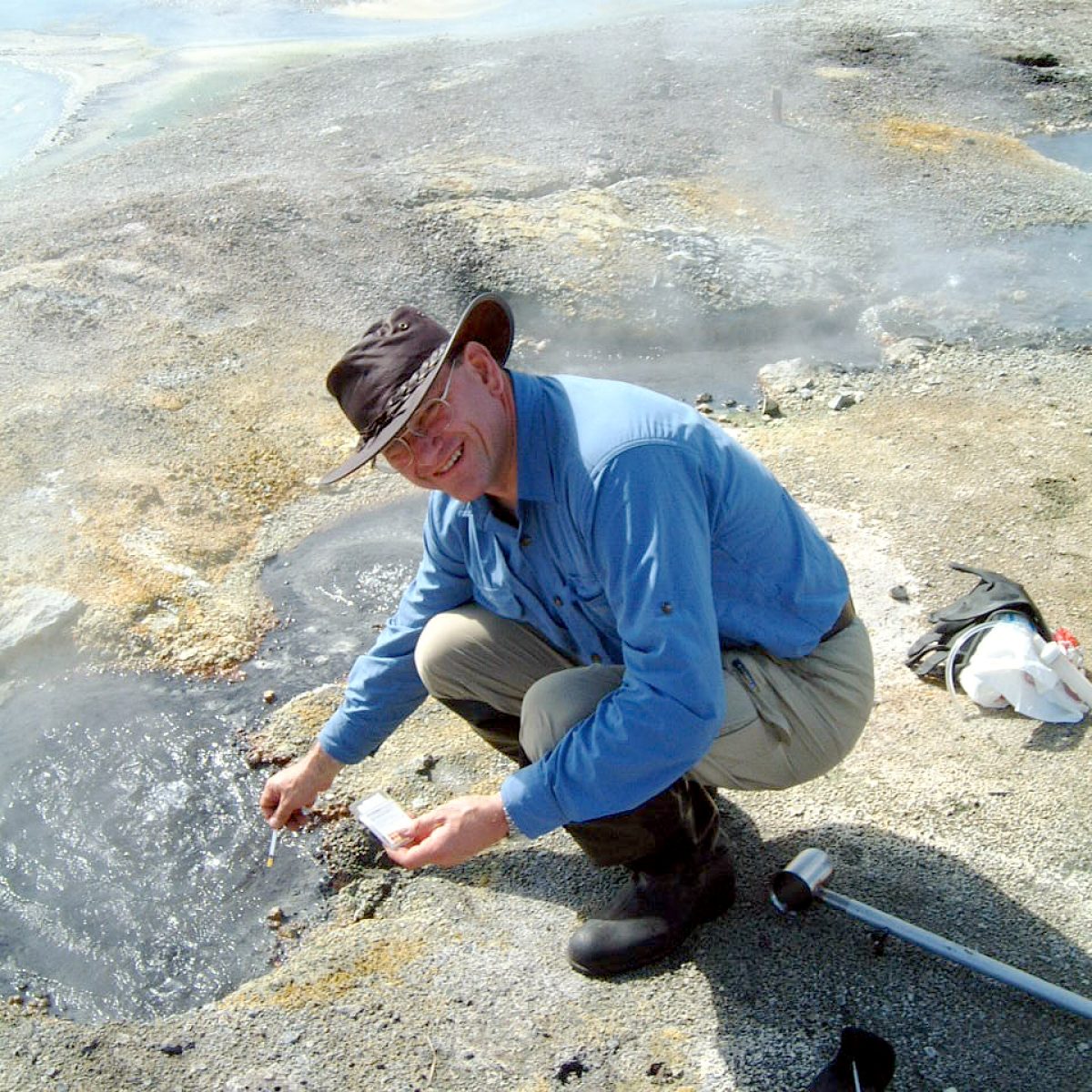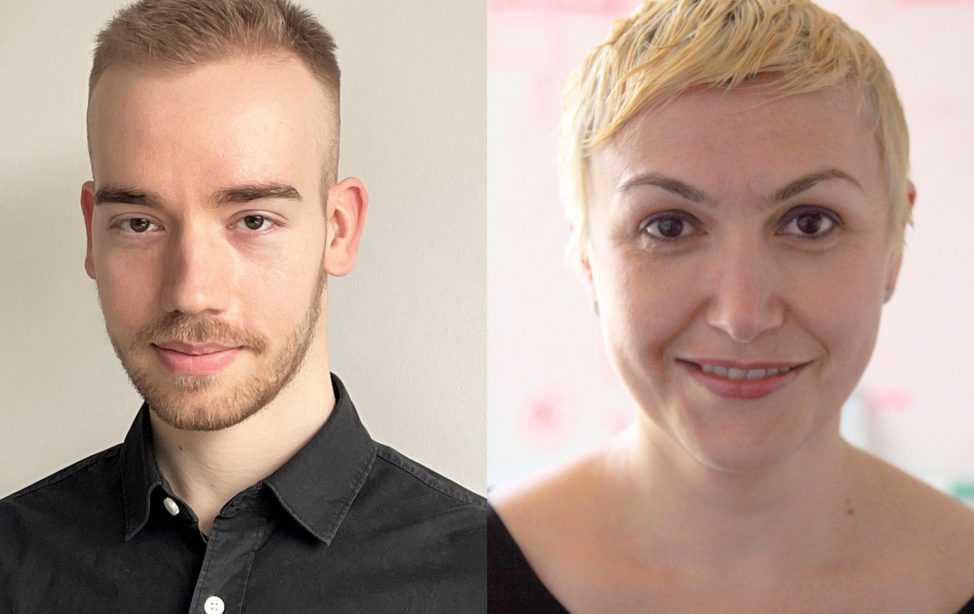
On the hunt for primeval microorganisms, Professor Dr. Karl-Otto Stetter travelled to the most inhospitable regions of our planet. In the photo you can see him taking samples from a geyser on the Kamchatka Peninsula in Northeast Asia (Image: private)
“I Didn’t Want a Secret Curiosity Shop“
A WIDE RANGE OF INTEREST
Given his interest in technology and biology, Karl-Otto Stetter studied Mechanical Engineering and Biology at TUM. Here, TUM Professor Dr. Otto Kandler nurtured his enthusiasm for Biology and Microbiology and became his mentor for many years. Under his guidance, Karl-Otto Stetter completed his diploma and doctorate.
Karl-Otto Stetter found studying at TUM “exhausting in a positive way”. The wide and varied array of different courses and internships presented a real challenge for the student who had multifaceted interests. But it was worth it. “At TUM I acquired a very broad spectrum of knowledge,” he says. “In my later research work I have benefitted from it countless times.”
UNABATED DESIRE TO EXPLORE
Karl-Otto Stetter’s lifelong field of research were so-called extremophiles. With great dedication he sampled, isolated, cultivated and classified these microorganisms, which have been living for millions of years under extreme conditions generally considered hostile to life. In the course of evolution, they managed to adapt to particularly low or high temperatures, to withstand high pressure or high saline levels, or even to survive without oxygen.
Extremophile organisms live in the deep sea, hydrothermal vents, volcanoes and glaciers. And Karl-Otto Stetter travelled to all these habitats. “On my travels, I visited areas which had hardly been exposed to people at all”, he says. “Sampling was so important to me that I always did it myself.” These samples allowed Karl-Otto Stetter later on to be able to successfully cultivate microorganisms in intensive and time-consuming laboratory work.
AT TUM I ACQUIRED A VERY BROAD SPECTRUM OF KNOWLEDGE. IN MY RESEARCH WORK I HAVE BENEFITTED FROM IT COUNTLESS TIMES.
CURIOUS FINDINGS
Karl-Otto Stetter made groundbreaking contributions to understanding the origins of life with his research on microorganisms, especially on Archaea. “My curiosity to discover and research new forms of life spurred me on”, he explains. “The exciting, often completely unexpected results obtained in the process continued to encourage me, so that I always gave it my all.”
Through his joint research with Wolfram Zillig, Karl-Otto Stetter was able to confirm Carl Woese’s revolutionary postulate of Archaea as the third domain of life. He himself has also discovered unknown primeval creatures: In a submarine hydrothermal region off Sicily, he discovered Pyrodictium, for example, which grow at temperatures of up to 110°C. In hydrothermal vents off Iceland’s coast, he discovered Nanoarchaeum equitans (the riding primeval dwarf) which has the smallest known genome. This heat-resistant microbe is only 400 nanometers in size and lives on the surface of another Archaeon.
“Due to the special and novel nature of the microbes I found, I collaborated and exchanged ideas with numerous researchers all around the world, who studied my findings from a variety of angles”, Karl-Otto Stetter explains. “After all, I didn’t want to just own a secret curiosity shop.” To this day, this attitude has not changed. Instead of microorganisms, Karl-Otto Stetter now cultivates rare orchids. Visitors are always welcome. In the year 2020, BR Television has been a frequent guest.

Karl-Otto Stetter (Image: private).
Prof. Dr. Karl-Otto Stetter
Diploma Biology 1969, Doctorate Microbiology 1973
Karl-Otto Stetter studied Mechanical Engineering and Biology at TUM. In 1969 he graduated with a diploma in Biology. In 1973 he received his doctorate in Microbiology with a thesis on lactobacilli. After a postdoc in Biochemistry at the Max Planck Institute for Biochemistry in Martinsried near Munich, he completed his habilitation in Microbiology and Botany at Ludwig-Maximilians-Universität München in 1977. From 1980 to 2002, Karl-Otto Stetter held the Chair of Microbiology at the Faculty of Natural Sciences III and was head of the Archae Center at the University of Regensburg. Since 2002 he is retired.
Karl-Otto Stetter is recognized as a pioneer in the research, cultivation and description of hyperthermophilic archaea and bacteria. With the Nanoarchaeota he discovered a new domain, nine new orders, eighteen new genera and over fifty new species. He is the author and co-author of over 360 scientific publications and has been invited to lecture more than 400 times, for example to the Vatican’s Pontifical Academy of Sciences, the Lawrence Berkeley National Laboratory in the USA or the University of Oxford in England. Karl-Otto Stetter is a member of numerous renowned scientific and academic societies, such as the National Academy of Sciences Leopoldina and the Bavarian Academy of Sciences. For his research he was awarded the Gottfried Wilhelm Leibniz Prize in 1988 and the Leeuwenhoek Medal of the Royal Netherlands Academy of Sciences in 2003, the highest distinction worldwide in the field of Microbiology.
Karl-Otto Stetter is married and has two daughters and a son. In his greenhouse he is growing over a thousand orchids, his winter garden is home to thriving Mediterranean plants, and on the meadow in front of his house rare wildflowers are blooming.


